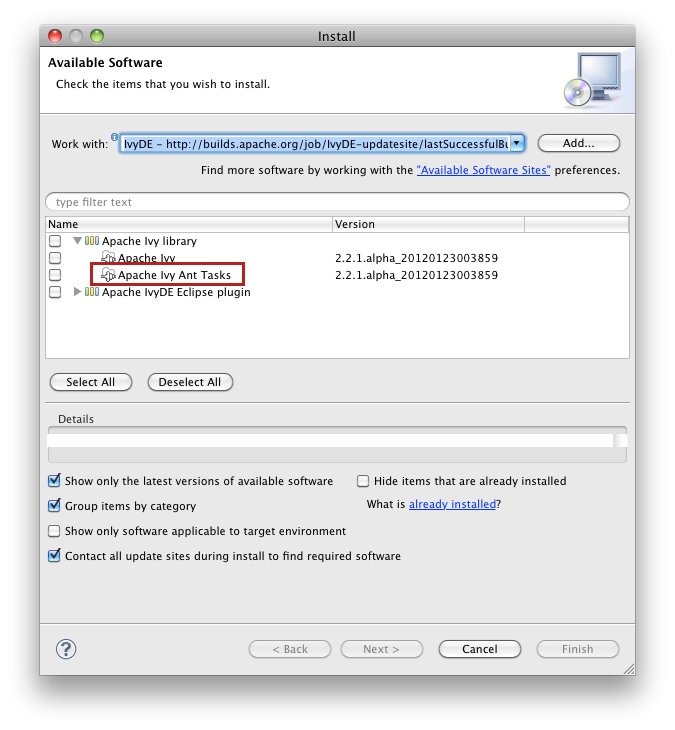Do the following steps to install Ant on your Mac OS X: Get the latest version of Apache Ant (binary distribution) from its official website (example link) Unzip the binary distribution and rename the folder to 'ant' move the folder to '/usr/local'. Terminal commands: mv ant /usr/local create a link of that folder after going. Installing Apache Ant on MAC is quite different from Windows. We use Terminal instead of cmd prompt in MAC. Steps to Install Apache Ant on MAC OS X: 1. Download the latest version of Apache Ant.

Hello Mac User! This Tutorial Shows You Step-by-Step How-to Install Apache Ant on Mac 10.12 Sierra OS X. And Ant for Mac Sierra is a build tool, a small program designed to help software teams develop big programs by automating all the drudge-work tasks of compiling code, running tests, and packaging the results for redistribution. Futhermore, Apache Ant is written in Java and is designed to be cross-platform, easy to use, extensible, and scalable. Finally, included in the Tutorial a Link to Getting Installed the Recommended Oracle Java JDK 7+ for Mac.
[english] The project is to extensions for Apache ant make available to create with the goal larger documents (for example, teaching scripts). Here are images, tables and drawings, etc. Transformed so that they can be processed with LaTeX. Additional functions available for the work, the neighbor create PDF accordingly. I have been trying to install ant on my mac with no luck, here is what i am doing.
In this tutorial, i will show you how to build your Java Application with Apache Ant. At 90% of our test is automated and to do so will need an automated means of build our project. This is when Apache Ant comes in handy. There are several types of Java build tools such as Maven, Gradle etc. Each of this build tools have their strengths and weaknesses.
What is Apache Ant As I explained above, it is an automated build tool for Java software build processes and also helps you manage your project from command line. Prerequisite • You need to have Apache installed. You can get it from • You need to have JDK installed. You can get it from • Have a Java IDE installed (I will be using ) Open your IDE and Create a new Java Project.
(I will call mine AntProject) Note When you create a NetBeans Project, it automatically generates an Ant file called build.xml which will compile, clean and build your project for you. I will go ahead and show you how you can create the build file your self so you can do a whole lot of customisation to your project. In Netbeans, switch to the File view and create a new xml file. I will call mine jbuild.xml. Delete the root tags and add project and description tag to the xml file so it looks like mine. Description of your project Description of your project We will give our project a name. #!/bin/bash #1.4 export ANT_HOME= /PDFdata /library /apache_ant / export PATH= $ANT_HOME /bin: $PATH ant -buildfile jbuild.xml main if [ $?

-eq 1 ]; then echo 'Failed on Build' exit 1 fi #!/bin/bash #1.4 export ANT_HOME=/PDFdata/library/apache_ant/ export PATH=$ANT_HOME/bin:$PATH ant -buildfile jbuild.xml main if [ $? -eq 1 ]; then echo 'Failed on Build' exit 1 fi if on Windows, click on Start –> Right click on computer –> Advance settings –> Environmental Variables and set variables for ANT.
Before you add the path to the existing path, make sure the exiting path has a semicolon at the end, if not add one before you paste the path. Once done open command line and type in ant. You should see something like this. Create a batch file and paste this code.
Install Apache On Mac
@ECHO OFF ant -buildfile jbuild.xml main IF ERRORLEVEL 1 ( echo 'Failed build' exit 1 ) @ECHO OFF ant -buildfile jbuild.xml main IF ERRORLEVEL 1 ( echo 'Failed build' exit 1 ) As you can see in both scripts, we call ant then specify the build file (jbuild.xml – the one we created) then we call the main target from the build. You can also run without calling the main target as we specified it as default in our project tag.

 0 kommentar(er)
0 kommentar(er)
